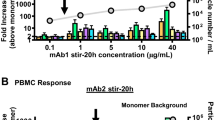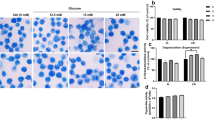Abstract
Gluten-induced aggregation of K562 cells represents an in vitro model reproducing the early steps occurring in the small bowel of celiac patients exposed to gliadin. Despite the clear involvement of TG2 in the activation of the antigen-presenting cells, it is not yet clear in which compartment it occurs. Herein we study the calcium-dependent aggregation of these cells, using either cell-permeable or cell-impermeable TG2 inhibitors. Gluten induces efficient aggregation when calcium is absent in the extracellular environment, while TG2 inhibitors do not restore the full aggregating potential of gluten in the presence of calcium. These findings suggest that TG2 activity is not essential in the cellular aggregation mechanism. We demonstrate that gluten contacts the cells and provokes their aggregation through a mechanism involving the A-gliadin peptide 31-43. This peptide also activates the cell surface associated extracellular TG2 in the absence of calcium. Using a bioinformatics approach, we identify the possible docking sites of this peptide on the open and closed TG2 structures. Peptide docks with the closed TG2 structure near to the GTP/GDP site, by establishing molecular interactions with the same amino acids involved in stabilization of GTP binding. We suggest that it may occur through the displacement of GTP, switching the TG2 structure from the closed to the active open conformation. Furthermore, docking analysis shows peptide binding with the β-sandwich domain of the closed TG2 structure, suggesting that this region could be responsible for the different aggregating effects of gluten shown in the presence or absence of calcium. We deduce from these data a possible mechanism of action by which gluten makes contact with the cell surface, which could have possible implications in the celiac disease onset.






Similar content being viewed by others
References
Akimov SS, Belkin AM (2001) Cell surface tissue transglutaminase is involved in adhesion and migration of monocytic cells on fibronectin. Blood 98:1567–1576
Auricchio S, De Ritis G, De Vincenzi M, Mancini E, Minetti M, Sapora O, Silano V (1984) Agglutinating activity of gliadin-derived peptides from bread wheat: implications for coeliac disease pathogenesis. Biochem Biophys Res Com 121:428–433
Auricchio S, De Ritis G, De Vincenzi M, Gentile V, Maiuri L, Mancini E, Porta R, Raia V (1990) Amines protect in vitro the celiac small intestine from the damaging activity of gliadin peptides. Gastroenterology 99:1668–1674
Badarau E, Wang Z, Rathbone DL, Costanzi A, Thibault T, Murdoch CE, El Alaoui S, Bartkeviciute M, Griffin M (2015) Development of potent and selective tissue transglutaminase inhibitors: their effect on TG2 function and application in pathological conditions. Chem Biol 22:1347–1361
Bergamini CM, Dondi A, Lanzara V, Squerzanti M, Cervellati C, Montin K, Mischiati C, Tasco G, Collighan R, Griffin M, Casadio R (2010) Thermodynamics of binding of regulatory ligands to tissue transglutaminase. Amino Acids 39:297–304
Bergamini CM, Collighan RJ, Wang Z, Griffin M (2011) Structure and regulation of type 2 transglutaminase in relation to its physiological functions and pathological roles. Adv Enzymol Relat Areas Mol Biol 78:1–46
Caputo I, Barone MV, Lepretti M, Martucciello S, Nista I, Troncone R, Auricchio S, Sblattero D, Esposito C (2010) Celiac anti-tissue transglutaminase antibodies interfere with the uptake of alpha gliadin peptide 31-43 but not of peptide 57-68 by epithelial cells. Biochim Biophys Acta 1802:717–727
Cervellati C, Montin K, Squerzanti M, Mischiati C, Ferrari C, Spinozzi F, Mariani P, Amenitsch H, Bergamini CM, Lanzara V (2012) Effects of the regulatory ligands calcium and GTP on the thermal stability of tissue transglutaminase. Amino Acids 42:2233–2242
Chladkova B, Kamanova J, Palova Jelinkova L, Cinova J, Sebo P, Tuckova L (2011) Gliadin fragments promote migration of dendritic cells. J Cell Mol Med 15:938–948
Cordella-Miele E, Miele L, Beninati S, Mukherjee AB (1993) Transglutaminase-catalyzed incorporation of polyamines into phospholipase A2. J Biochem 113:164–173
Dewar DH, Ciclitira P (2005) Clinical features and diagnosis of celiac disease. Gastroenterology 128:S19–S24
Dieterich W, Ehnis T, Bauer M, Donner P, Volta U, Riecken EO, Schuppan D (1997) Identification of tissue transglutaminase as the autoantigen of celiac disease. Nat Med 3:797–801
Dieterich W, Esslinger B, Trapp D, Hahn E, Huff T, Seilmeier W, Wieser H, Schuppan D (2006) Cross linking to tissue transglutaminase and collagen favours gliadin toxicity in coeliac disease. Gut 55:478–484
Dorum S, Arntzen MO, Qiao SW, Holm A, Koehler CJ, Thiede B, Sollid LM, Fleckenstein B (2010) The preferred substrates for transglutaminase 2 in a complex wheat gluten digest are Peptide fragments harboring celiac disease T-cell epitopes. PLoS One 5:e14056
Farrè Castany MA, Kocna P, Tlaskalova-Hogenova H (1995) Binding of gliadin to lymphoblastoid, myeloid and epithelial cell lines. Folia Microbiol (Praha) 40:431–435
Fiorucci S, Zacharias M (2010) Binding site prediction and improved scoring during flexible protein-protein docking with ATTRACT. Proteins 78:3131–3139
Fleckenstein B, Molberg O, Qiao SW, Schmid DG, von der Mülbe F, Elgstoen K, Jung G, Sollid LM (2002) Gliadin T cell epitope selection by tissue transglutaminase in celiac disease. Role of enzyme specificity and pH influence on the transamidation versus deamidation process. J Biol Chem 277:34109–34116
Fleckenstein B, Qiao SW, Larsen MR, Jung G, Roepstorff P, Sollid LM (2004) Molecular characterization of covalent complexes between tissue transglutaminase and gliadin peptides. J Biol Chem 279:17607–17616
Green PH, Cellier C (2007) Celiac disease. N Engl J Med 357:1731–1743
Griffin M, Mongeot A, Collighan R, Saint RE, Jones RA, Coutts IG, Rathbone DL (2008) Synthesis of potent water-soluble tissue transglutaminase inhibitors. Bioorg Med Chem Lett 18:5559–5562
Hodrea J, Demeny MA, Majai G, Sarang Z, Korponay-Szabo IR, Fesus L (2010) Transglutaminase 2 is expressed and active on the surface of human monocyte-derived dendritic cells and macrophages. Immunol Lett 130:74–81
Inczedy J, Lengyel T, Ure AM (2002) Compendium of analytical nomenclature, definitive rules 1997. International Union of Pure and Applied Chemistry (IUPAC), Web edition
Jang TH, Lee DS, Choi K, Jeong EM, Kim IG, Kim YW, Chun JN, Jeon JH, Park HH (2014) Crystal structure of transglutaminase 2 with GTP complex and amino acid sequence evidence of evolution of GTP binding site. PLoS One 9:e107005
Lozzio BB, Lozzio CB, Bamberger EG, Feliu AS (1981) A multipotential leukemia cell line (K562) of human origin. Exp Biol Med 166:546–550
Mischiati C, Sereni A, Lampronti I, Bianchi N, Borgatti M, Prus E, Fibach E, Gambari R (2004) Rapamycin-mediated induction of gamma-globin mRNA accumulation in human erythroid cells. Br J Haematol 126:612–621
Mischiati C, Ura B, Roncoroni L, Elli L, Cervellati C, Squerzanti M, Conte D, Doneda L, Polverino de Laureto P, de Franceschi G, Calza R, Barrero CA, Merali S, Ferrari C, Bergamini CM, Agostinelli E (2015) Changes in protein expression in two cholangiocarcinoma cell lines undergoing formation of multicellular tumor spheroids in vitro. PLoS One 10:e0118906
Mitkevich OV, Shainoff JR, DiBello PM, Yee VC, Teller DC, Smejkal GB, Bishop PD, Kolotushkina IS, Fickenscher K, Samokhin GP (1998) Coagulation factor XIIIa undergoes a conformational change evoked by glutamine substrate. Studies on kinetics of inhibition and binding of XIIIA by a cross-reacting antifibrinogen antibody. J Biol Chem 273:14387–14391
Mohler WA, Charlton CA, Blau HM (1996) Spectrophotometric quantitation of tissue culture cell number in any medium. Biotechniques 21:260–266
Nurminskaya MV, Belkin AM (2012) Cellular functions of tissue transglutaminase. Int Rev Cell Mol Biol 294:1–97
Oberhuber G, Granditsh G, Vogelsang H (1999) The histopathology of coeliac disease: time for a standardized report scheme for pathologists. Eur J Gastroenterol Hepatol 11:1185–1194
Pinkas DM, Strop P, Brunger AT, Khosla C (2007) Transglutaminase 2 undergoes a large conformational change upon activation. PLoS Biol 5:e327
Rauhavirta T, Lindfors K, Koskinen O, Laurila K, Kurppa K, Saavalainen P, Mäki M, Collin P, Kaukinen K (2014) Impaired epithelial integrity in the duodenal mucosa in early stages of celiac disease. Transl Res 164:223–231
Saladin A, Rey J, Thévenet P, Zacharias M, Moroy G, Tufféry P (2014) PEP-SiteFinder: a tool for the blind identification of peptide binding sites on protein surfaces. Nucleic Acids Res 42:W221–W226
Siegel M, Strnad P, Watts RE, Choi K, Jabri B, Omary MB, Khosla C (2008) Extracellular transglutaminase 2 is catalytically inactive, but is transiently activated upon tissue injury. PLoS One 3:e1861
Silano M, Vincentini O, Luciani A, Felli C, Caserta S, Esposito S, Villella VR, Pettoello-Mantovani M, Guido S, Maiuri L (2012) Early tissue transglutaminase-mediated response underlies K562(S)-cell gliadin-dependent agglutination. Pediatr Res 71:532–538
Skovbjerg H, Noren O, Anthonsen D, Moller J, Sjostrom H (2002) Gliadin is a good substrate of several transglutaminases: possible implication in the pathogenesis of coeliac disease. Scand J Gastroenterol 37:812–817
Skovbjerg H, Hansen GH, Niels-Christiansen LL, Anthonsen D, Ascher H, Midhagen G, Hallert C, Noren O, Sjostrom H (2004a) Intestinal tissue transglutaminase in coeliac disease of children and adults: ultrastructural localization and variation in expression. Scand J Gastroenterol 39:1219–1227
Skovbjerg H, Koch C, Anthonsen D, Sjostrom H (2004b) Deamidation and cross-linking of gliadin peptides by transglutaminases and the relation to celiac disease. Biochim Biophys Acta 1690:220–230
Skovbjerg H, Anthonsen D, Knudsen E, Sjostrom H (2008) Deamidation of gliadin peptides in lamina propria: implications for celiac disease. Dig Dis Sci 53:2917–2924
Sollid LM (2002) Coeliac disease: dissecting a complex inflammatory disorder. Nat Rev Immunol 2:647–655
Stamnaes J, Pinkas DM, Fleckenstein B, Khosla C, Sollid LM (2010) Redox regulation of transglutaminase 2 activity. J Biol Chem 285:25402–25409
Sutherland JA, Turner AR, Mannoni P, McGann LE, Turc JM (1986) Differentiation of K562 leukemia cells along erythroid, macrophage, and megakaryocyte lineages. J Biol Response Mod 5:250–262
Telci D, Wang Z, Li X, Verderio EA, Humphries MJ, Baccarini M, Basaga H, Griffin M (2008) Fibronectin-tissue transglutaminase matrix rescues RGD-impaired cell adhesion through syndecan-4 and beta1 integrin co-signaling. J Biol Chem 283:20937–20947
Tjon JM, van Bergen J, Koning F (2010) Celiac disease: how complicated can it get? Immunogenetics 62:641–651
Uhlig H, Osman AA, Tanev ID, Viehweg J, Mothes T (1998) Role of tissue transglutaminase in gliadin binding to reticular extracellular matrix and relation to coeliac disease autoantibodies. Autoimmunity 28:185–195
van de Wal Y, Kooy YM, van Veelen PA, Pena SA, Mearin LM, Molberg O, Lundin KE, Sollid LM, Mutis T, Benckhuijsen WE, Drijfhout JW, Koning F (1998) Small intestinal T cells of celiac disease patients recognize a natural pepsin fragment of gliadin. Proc Natl Acad Sci USA 95:10050–10054
Wang Z, Griffin M (2012) TG2, a novel extracellular protein with multiple functions. Amino Acids 42:939–949
Wang Z, Collighan RJ, Gross SR, Danen EH, Orend G, Telci D, Griffin M (2010) RGD-independent cell adhesion via a tissue transglutaminase-fibronectin matrix promotes fibronectin fibril deposition and requires syndecan-4/2 α5β1 integrin co-signaling. J Biol Chem 285:40212–40229
Wang Z, Collighan RJ, Pytel K, Rathbone DL, Li X, Griffin M (2012) Characterization of heparin-binding site of tissue transglutaminase: its importance in cell surface targeting, matrix deposition, and cell signaling. J Biol Chem 287:13063–13083
Zhang J, Lesort M, Guttmann RP, Johnson GV (1998) Modulation of the in situ activity of tissue transglutaminase by calcium and GTP. J Biol Chem 273:2288–2295
Zimmermann C, Rudloff S, Lochnit G, Arampatzi S, Maison W, Zimmer KP (2014) Epithelial transport of immunogenic and toxic gliadin peptides in vitro. PLoS One 9:e113932
Author information
Authors and Affiliations
Corresponding author
Ethics declarations
Conflict of interest
The authors declare that they have no conflict of interest.
Research involving human participants and/or animals
This article does not contain any studies with human participants or animals performed by any of the authors.
Additional information
Handling Editors: S. Beninati, M. Piacentini, C. M. Bergamini.
Rights and permissions
About this article
Cite this article
Feriotto, G., Calza, R., Bergamini, C.M. et al. Involvement of cell surface TG2 in the aggregation of K562 cells triggered by gluten. Amino Acids 49, 551–565 (2017). https://doi.org/10.1007/s00726-016-2339-4
Received:
Accepted:
Published:
Issue Date:
DOI: https://doi.org/10.1007/s00726-016-2339-4




